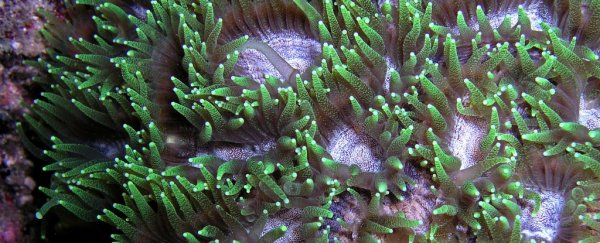Coral in Australia has had a pretty rough year. Back in April, it was reported that 93 percent of the Great Barrier Reef in Queensland had been damaged by rising temperatures, and researchers found that coral in Sydney Harbour had been extensively bleached for the first time.
But there's finally some good news - for the Sydney coral, at least – because a follow-up study has found that nearly all coral in the area is showing signs of recovery, just months after the bleaching incident.
"Up to 45 percent of corals at selected sites were bleached in April, which was unprecedented this far south of the tropics. However, as of now, almost every single coral we tracked is showing signs of recovery," said one of the researchers, Samantha Goyen, from the University of Technology, Sydney (UTS).
Coral undergo bleaching as a last ditch effort to survive in waters that are too hot or polluted. As Fiona Macdonald explained for us earlier this year:
"Corals get their beautiful vibrant colour from tiny algae that live in their tissue and provide food in return for a home."
"But when water temperatures get too warm, the corals become stressed and eject the algae, which turns the coral bone white and also leaves them starving and vulnerable to destruction."
The longer the algae is gone from the coral, the less likely the coral will be able survive.
"Bleaching is a symptom that the coral is struggling under the conditions. What we have seen is a strong aptitude for recovery in the Sydney Harbour corals following the return to normal water temperatures," said Goyen.
Although less than six months ago, 45 percent of the corals, known as scleractinia, in some areas in Sydney Harbour were dangerously bleached, now the corals are recovering well.
Unfortunately, the coral on the Great Barrier Reef haven't been as lucky, because although some of the coral is repairing itself, over 30 percent of it is dead or dying. The researchers think that Sydney scleractinia coral might be more hardy then its northern counterparts.
"Their biology appears to be robust. The widespread coral recovery [in Sydney] observed as temperatures returned to normal suggests these corals may also have some unique characteristics that make them incredibly hardy," said one of the team, Matthew Nitschke.
"Their condition is even more impressive given that the recovery period also included a significant storm event for Sydney Harbour in June, which would have likely stirred up sediment and limited light availability for some time."
The researchers are yet to publish their findings, but this hardier Sydney Harbour coral, could give us a better understanding into how coral responds to environmental stress, and how we might be able to lend a hand in the recovery process.
"Our goal is to investigate the characteristics of corals that determine who wins and who loses during extreme events," said Joshua Madin from Macquarie University.
"The Sydney Harbour corals are teaching us a lot about what it takes to live in cooler climates, but also about the possibility of these cooler places as refuges for corals in the future when seas will be warmer."
The researchers are currently looking into long-term experiments with these corals to see how they recover over greater periods of time.
"The recovery mechanism following stress for these corals is yet to be identified, but this mechanism is important to understand in order to predict coral resilience into the future," said David Suggett, who led the team at UTS.
"We know that coral ecosystems and populations can bounce back from disturbances, but this is highly dependent on a sufficient disturbance-free window of time. With the global coral bleaching event now into its second consecutive year, we can only see this as nature's warning shot."
UTS Science is a sponsor of ScienceAlert. Find out more about their research.
